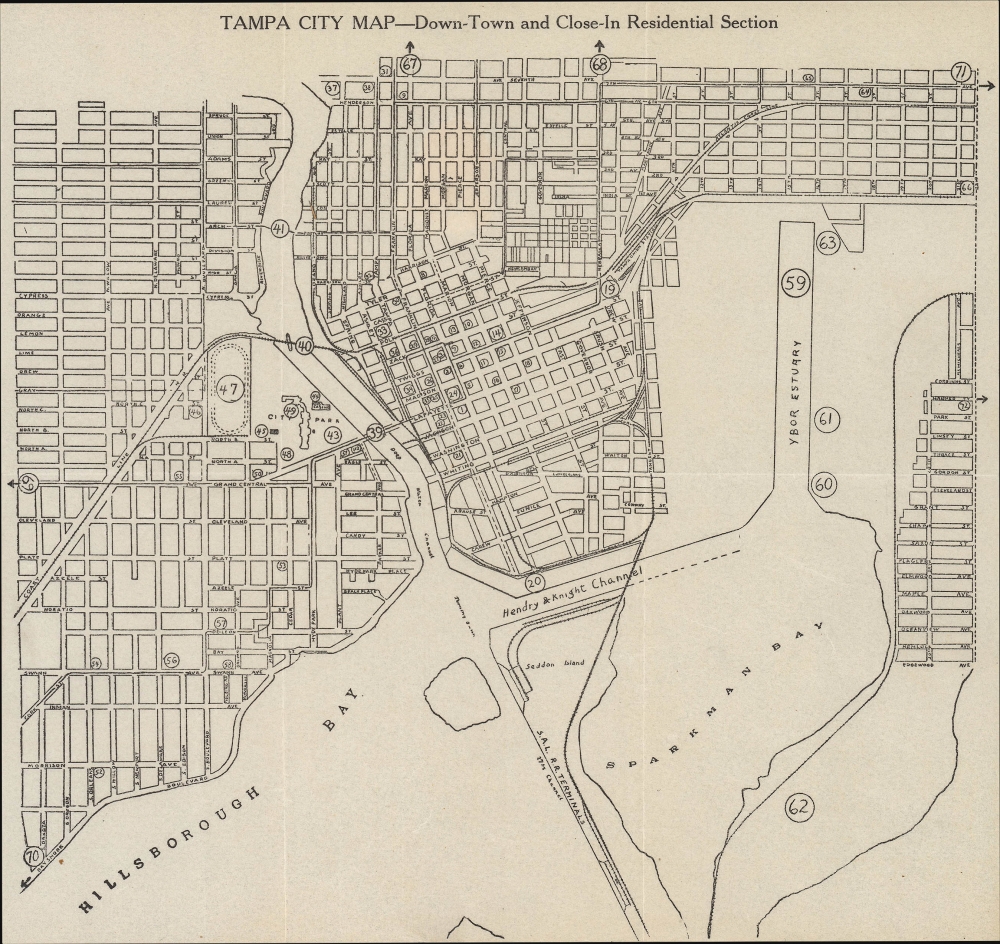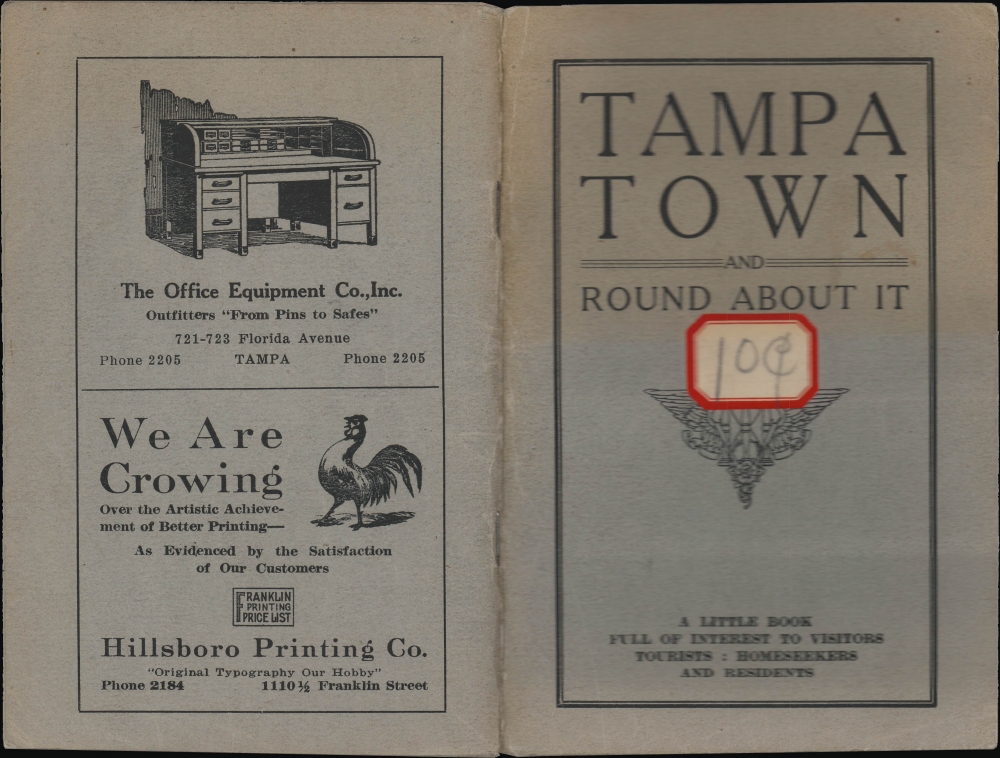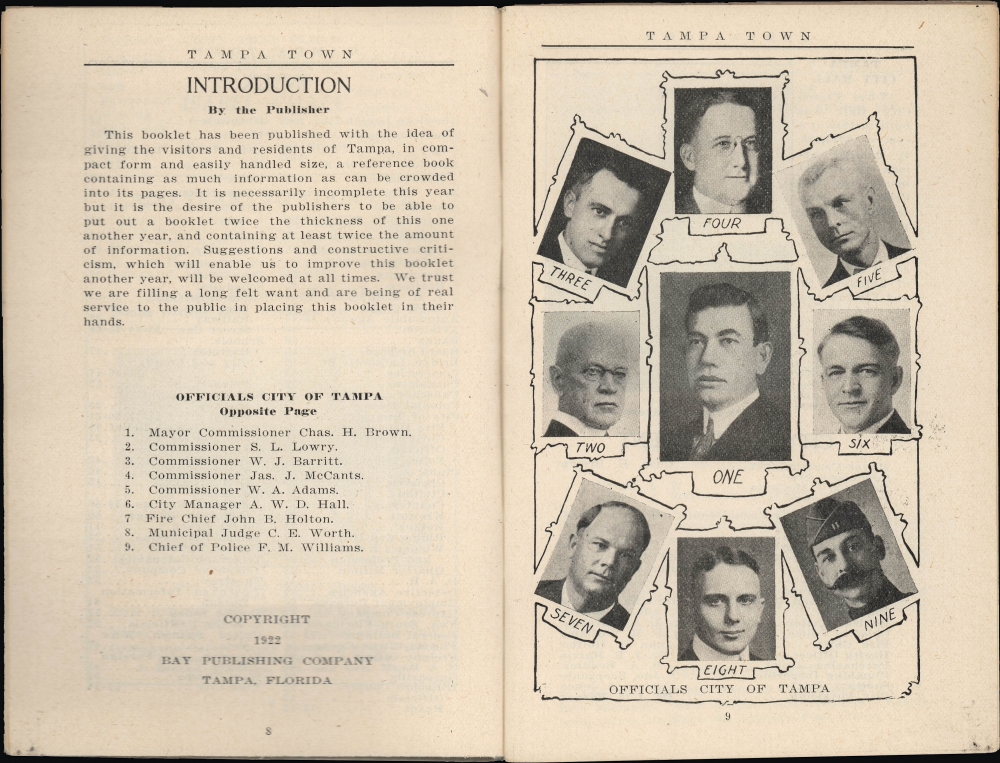1922 Bay Publishing Co. Map of Tampa, Florida
Tampa-baypublishingco-1922$250.00

Title
Tampa City Map - Down-town and Close-in Residential Section.
1922 (dated) 8.5 x 9 in (21.59 x 22.86 cm) 1 : 20500
1922 (dated) 8.5 x 9 in (21.59 x 22.86 cm) 1 : 20500
Description
This is a 1922 folding map of Tampa published by the Bay Publishing Company. It captures the city as it was growing at a tremendous rate, part of the wider tourist and migration wave that swept into Florida in the 1920s, and is notable, among other features, for references to the city's robust illicit economy built around alcohol and gambling.
Unsurprisingly, organized crime soon took over these enterprises, and violence followed. Charlie Wall, the troubled son of a former mayor of Tampa, came to dominate gambling and bootlegging in Tampa, but was challenged by several rivals, including the Trafficante Family, who may have ordered his murder in 1955. City officials were easily corrupted to prevent any restrictions on these lucrative illegal practices. In 1922, Tampa's new police chief, World War I veteran Frank Williams (whose photograph appears on page 9 of the booklet), launched a widespread crackdown on gambling and bootlegging, but was unable to secure convictions from local judges, who were in the pay of organized crime.
Flagler and other boosters of the region successfully promoted it as a paradisical escape from the grimy cities and cold weather of New England and the Mid-Atlantic. Land prices shot up at an astronomical rate and developers carved entirely new cities out of wetlands in mere months. In addition to Flagler's railway, the arrival of the highway system and associated businesses (gas stations, motels, restaurants, etc.) in the 1920s made the region more easily accessible. But the speculation around land prices in Florida had reached irrational heights, and the damage caused by two hurricanes followed by the financial crash of 1929 led to a collapse in the real estate market, ruining many investors in the process.
A Closer Look
Taking in the contemporary city of Tampa, this map accompanies a booklet providing comprehensive information on the city to visitors and residents alike. The numbers on the map correspond to a key that appears on page 39 and 40 of the booklet. Towards top-right (number 19) is Tampa Union Station, opened in 1912 and still used by Amtrak. The track across the street from City Park (Plant Park), Plant Field, was used for multiple purposes, including baseball and early automobile racing. The entire area had been conceived by industrialist and railroad magnate Henry B. Plant (1819 - 1899), and was centered around Plant's opulent Tampa Bay Hotel (number 49 on the map), now the Henry B. Plant Museum. Aside from the numbered locations, streets, rail lines, and waterways are labelled throughout.Cigars, Booze, and Gambling
At this time, Tampa was a growing, dynamic city with a heady atmosphere. The city's population more than doubled between 1920 and 1925, from 52,000 to 119,000, and, as referenced in the booklet, many local businessmen and civic leaders aimed for a population of 250,000 by 1930. Ybor City, at right, was the heart of both Tampa's economy and the American cigar industry, employing mostly immigrants from Cuba and elsewhere in the Caribbean, including many children, as cigar rollers. West Tampa, beyond the scope of this map, was a thriving regional center of gambling and illegal alcohol sales after Tampa went 'dry' in 1919. In Tampa proper, a casino is labelled here (number 44) in City Park, while a 'Spanish Casino' appears at top-right (number 65). Moreover, the lottery game bolita was pervasive throughout the city, providing endless opportunities for gambling.Unsurprisingly, organized crime soon took over these enterprises, and violence followed. Charlie Wall, the troubled son of a former mayor of Tampa, came to dominate gambling and bootlegging in Tampa, but was challenged by several rivals, including the Trafficante Family, who may have ordered his murder in 1955. City officials were easily corrupted to prevent any restrictions on these lucrative illegal practices. In 1922, Tampa's new police chief, World War I veteran Frank Williams (whose photograph appears on page 9 of the booklet), launched a widespread crackdown on gambling and bootlegging, but was unable to secure convictions from local judges, who were in the pay of organized crime.
Florida Land Boom
In the late 19th and early 20th century, Florida experienced a series of land booms and crashes; the most well-known of these occurred in the 1920s. The collapse of a previous land boom that established Florida as a center for the citrus industry in the 1880s - 1890s allowed for the easy acquisition of large tracts of land at cut-rate prices. Industrialist and founder of Standard Oil Henry Flagler (1830 - 1913) seized the opportunity to build his Florida East Coast Railway and extend it to the region that would develop into Miami and other communities on the state's southeastern coast.Flagler and other boosters of the region successfully promoted it as a paradisical escape from the grimy cities and cold weather of New England and the Mid-Atlantic. Land prices shot up at an astronomical rate and developers carved entirely new cities out of wetlands in mere months. In addition to Flagler's railway, the arrival of the highway system and associated businesses (gas stations, motels, restaurants, etc.) in the 1920s made the region more easily accessible. But the speculation around land prices in Florida had reached irrational heights, and the damage caused by two hurricanes followed by the financial crash of 1929 led to a collapse in the real estate market, ruining many investors in the process.
Publication History and Census
This map was published as part of the booklet Tampa town and round about it 1922: a littlle book full of interest to visitors, tourists, homeseekers and residents by the Bay Publishing Company, a short-lived local operation, and likely was produced with the help of the city government and Board of Trade. The map is not independently cataloged by any institution and only one example of the entire booklet is noted in the OCLC, while the Touchton Map Library at the Tampa Bay History Center holds two examples of the booklet.Source
Alduino, F., 'The Damnedest Town This Side of Hell: Tampa 1920-29 (Part 1),' Sunland Tribune, Vol. 16, Article 6 (1990).
Condition
Very good. Light wear along original fold lines. Accompanied by original booklet.
References
OCLC 1376017225. Tampa Bay History Center Touchton Map Library 2015.008.032 and 2019.048.025.






